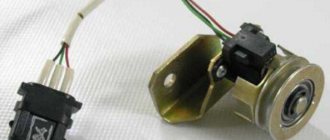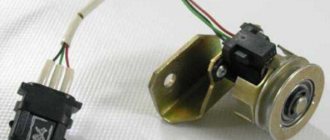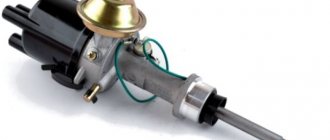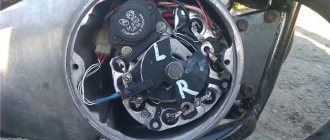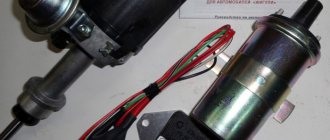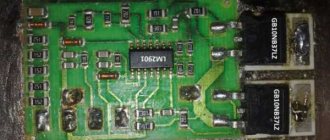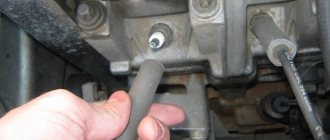Author: Evgeny Zhivoglyadov. Publication date: December 18, 2022. Category: Automotive equipment.
In order for a gasoline engine to work, the fuel must ignite in its cylinders. It is truth. Therefore, the ignition system (at first, naturally, contact) appeared simultaneously with the car. But progress does not stand still. He, of course, also affected the ignition system: the traditional method of generating a spark was replaced by a more efficient and reliable one, namely, non-contact. This will be discussed in this article.
The main differences between traditional and contactless ignition systems
When a gasoline engine is running, sparking (that is, the supply of high voltage to the spark plug) occurs at the moment when the low-voltage power circuit of the ignition coil is opened. In a traditional system, such a “switch” is the contacts of a mechanical breaker, which periodically open when they come into contact with the cams of the rotating rotor of the distributor.
It was this unit that was replaced during the transition to a contactless system. The control signal in it is generated by a special sensor (inductive, optical or Hall sensor) installed under the distributor cover. An electrical impulse is sent to a semiconductor switch, which controls the primary winding of the ignition coil.
On a note! It is still impossible to fully call the ignition system of most modern cars (mid-price category) contactless. The fact is that the contacts installed in the distributor cap still participate in the sparking process, because it is through them and the slider that high voltage is supplied to the spark plugs.
What does the BSZ consist of?
Contactless ignition includes a small number of parts, thereby reducing the likelihood of failure of each of them. The system consists of:
- Power supply. In all cars it is the battery.
- Ignition and starter switch. The part is necessary for the correct distribution of operating time of the device.
- Ignition coil. Converts low-voltage current from the battery into high-voltage, which ensures stable operation of the car.
- Transistor switch. Responsible for interrupting the flow of electrical current to the coil.
- Ignition sensor. Detects changes in the magnetic field.
- Distribution sensor. The sensor is combined with a pulse sensor, which comes in several types. The pulse sensor is most often represented by a Hall sensor, but there are also two more varieties - inductive and optical.
- Candles.
We recommend: Features, advantages and disadvantages of low-profile car tires
Advantages and disadvantages of a contactless ignition system
Despite the fact that the contactless ignition system (BSI) is more expensive (this is perhaps its only drawback) compared to the traditional one, it is now used in all modern cars. Better sparking in BSZ is due to the fact that due to the use of a semiconductor switch, energy losses on the primary winding of the coil are reduced, and this, in turn, leads to an increase in voltage on the secondary. As a result, more complete combustion of the fuel-air mixture occurs in the engine cylinders. Hence all the ensuing advantages of a contactless ignition system:
- increase in engine power;
- fuel economy;
- improving the dynamic characteristics of the car;
- reduction of exhaust gas toxicity;
- confident engine starting in conditions of high humidity and high negative temperatures;
- stable engine operation at various speeds (up to maximum);
- increasing the service life of spark plugs.
Useful tips
- Since most often the cause of malfunctions lies in the condition of the wires, you should not skimp on them. High-quality wires that have silicone insulation are durable and reliable.
- Incorrect fastening of the wire block is often the reason why the switch breaks. After installing the part, it is necessary to check the condition of the connector.
- If, after installing a contactless ignition system, the tachometer no longer performs its functions, then it is necessary to additionally install a capacitor in the circuit between it and the coil.
Methods for converting a contact ignition system into a contactless one
Naturally, a huge number of cars (both imported and domestic) equipped with a standard ignition system travel along the roads of our vast Motherland. Increasing the efficiency and reliability of its operation is the dream of any vehicle owner. Nowadays, doing it yourself is quite easy. There are two main ways (we do not consider the option of a completely homemade device) to modernize the ignition system:
- Purchase and installation of a complete set of contactless ignition. Although this tuning option is quite expensive, experts consider it the most “correct” from a technical point of view. Only by completely replacing the standard ignition system can you get a new one that has all the advantages of contactless sparking.
- Modification of the “native” distributor by installing a special module, which is a small-sized “3 in 1” device (sensor, signal amplifier and switching transistor). This modernization option is less expensive and allows you to slightly improve the technical characteristics of the traditional ignition system by eliminating the “problematic” mechanical breaker from the circuit.
On a note! Manufacturers of automobile parts offer users kits that allow them to modify ignition systems for various vehicle models, in accordance with the options described above.
A budget option for switching to a contactless system
The contacts of the mechanical breaker “burn out” and wear out, so they have to be periodically cleaned and the gap adjusted. Installing the Sonar IR module (costing 700÷900 rubles) in the distributor allows owners of classic VAZs (2101-2107) to be spared from this routine work.
The device consists of:
- optical sensor (infrared radiation source and photodetector);
- electrical signal amplifier;
- switching transistor.
Important! All of the above is mounted in a miniature waterproof housing, which makes it quite easy to install it in place of a standard contact breaker.
The operating principle of the module is as follows:
- When the distributor rotor rotates, its cams periodically block the light flux of the optical sensor.
- Electrical impulses from the photodetector are amplified by a built-in microcircuit and supplied to a control transistor, which opens/closes the circuit of the primary winding of the coil.
On a note! LED indicators (red and green) inform about the state of the electronic switching key (closed/open).
How to install and configure Sonar IR is described in detail in the video below:
Contactless sensor-breaker for foreign cars
Owners of foreign cars can purchase a simple device from UltraSpark, Pertronix or AccuSpark, which allows them to quickly “convert” a standard ignition system into a contactless one. The delivery package for this device includes:
- Induction sensor-interrupter.
- A plastic trigger ring with neodymium magnets pressed into it (according to the number of engine cylinders).
- Installation instructions and connection diagram.
According to manufacturers, installation of a non-contact sensor-interrupter (BSD) takes no more than 30 minutes:
- Remove the distributor cover and slider.
- We dismantle the contact group of the mechanical breaker and the spark-extinguishing capacitor.
- We install the BDP and bring its wires out through the hole in the housing.
- We put a trigger ring on the rotor axis.
- We return the slider and distributor cover to their place.
- We connect the wires from the installed sensor to the ignition coil in accordance with the diagram.
Important! Knowing the distributor model, you can select a contactless breaker module for almost any brand of foreign-made vehicle.
The undoubted advantages of the BDP are:
- Low cost.
- Easy to install.
- Possibility of use with stock distributors and high-voltage coils of a specific car brand.
Complete non-contact ignition system
Naturally, you won’t be able to get all the benefits of the BSZ by installing only a sensor-interrupter. This module only improves the reliability of sparking (without skipping) and relieves owners from the need to constantly monitor the condition of the mechanical contact group. In order to equip your car with a full-fledged BSZ, you need to purchase a kit consisting of:
- distributor, with installed Hall sensor;
- semiconductor switch;
- high voltage coil;
- connecting wires with installed blocks.
Such a set for classic VAZ cars from SOATE (Russia, Stary Oskol) currently costs about 2,500 rubles. The video below describes in detail the process of installing it yourself:
Instructions for installing a homemade BSZ
If you have decided which ignition is better, then let’s move on to the issue of installing a better option on your car. Installation of contactless ignition begins with the installation of a block equipped with a steel plate with mounting holes, which is necessary for cooling. Let's look at the procedure using the example of a classic VAZ 2107 car. There should be holes on the left side member to which the switch is screwed using two self-tapping screws. If there is no hole, then find a place next to the coil and drill holes there (the author of the video is the Sdelaj Sam channel! Pljus interesnoe!).
When installing a homemade electronic ignition, the switch cannot be mounted next to the washer reservoir. After all, if it leaks, then all the electronics will be “covered.” Before dismantling high-voltage wires, remember their location.
Installation of BSZ is carried out in the following order:
- First, you need to remove the cover from the new distributor and install the gasket. The distributor is mounted on the block so that its moving contact is located opposite the mark on the valve cover of the power unit. The so-called distributor skirt should be slightly pressed using a fastening nut, this will prevent possible rotation of the distributor.
- Next, you need to install the coil at the installation site. After this, you should connect the wires from the lock relay, switch, and tachometer to its terminals. The wire that comes from pin 1 on the block must be connected to terminal K directly on the coil. As for the wire from pin number 4, it is connected to terminal B.
- After performing these steps, you need to set the gap on the electrodes of the spark plugs to about 0.8-0.9 mm, and then the spark plugs themselves can be screwed into the seats. Place the cover on the distribution unit and connect all the necessary wires in the appropriate order. Then all you have to do is connect the vacuum line. Having done this, you can begin adjusting the unit.
1. Disconnect the wires from the distributor.
2. Remove the distributor.
3. Install the switch.
Ignition system without distributor
The most “advanced” and truly contactless is the electronic ignition system, which does not have a mechanical distributor, since its functions are performed by the on-board computer. It “determines” the moment of spark formation in the corresponding cylinder based on signals received from the camshaft and crankshaft position sensors. Instead of one high-voltage coil, the system uses several (one for each engine cylinder). This allows you to create a more powerful spark, since the computer, depending on the engine speed, clearly “determines” the time required to accumulate energy.
On a note! Even more innovative is the ignition system, in which the coils are mounted directly into caps placed on the spark plugs. This allows you to get rid of high-voltage wires, which in turn reduces electricity losses, and also increases the reliability and efficiency of the sparking process.
Possible faults
If the car does not start, you should first check that the wiring is connected correctly. You can also unscrew the spark plugs and check for a spark.
It is quite possible that the distributor was positioned incorrectly during installation, in particular, the Hall sensor did not align with the center of the technological hole, and as a result, the moment of sparking was disrupted.
To eliminate the malfunction, you should make a new adjustment with preliminary installation of marks on the pulley with marks on the cover, setting the position of the slider, and then install the Hall sensor.
It is also possible that the contactless ignition of the VAZ-2101 does not work because one of the components is simply faulty. Therefore, before installation, it is advisable to check the switch, distributor and coil on a car equipped with such an ignition system.

